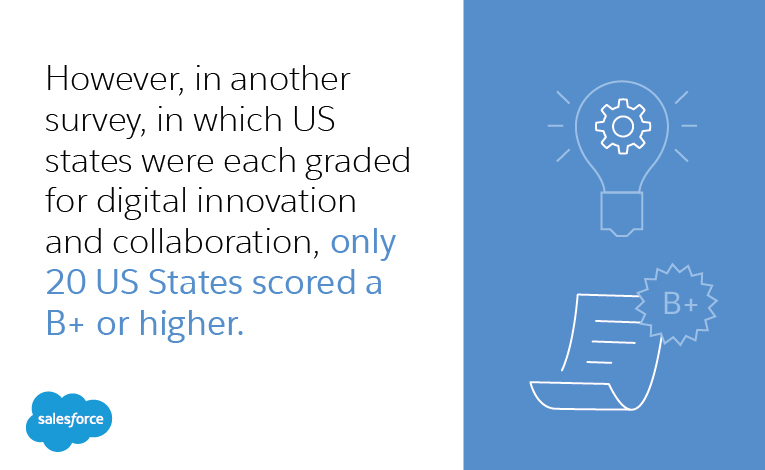From G to Z: Getting the Most Out of E-Governance


It’s clear that the United States leads the way in embracing new technology. However, in another survey, in which US states were each graded for digital innovation and collaboration, only 20 US States scored a B+ or higher. Furthermore, in Forrester’s 2016 US Customer Experience Index, 73% of federal agencies fell into the lowest two categories for customer experience (poor and very poor), and all agencies averaged a score of just 58 out of 100, compared with the private sector’s average score of 70.
It is also evident then, that there is still plenty of room for improvement, especially if the US government wants to remain ahead of the curve. This extends across every area of e-governance: government to citizen (G2C), government to business (G2B), government to government (G2G), and government to employees (G2E). Let’s break down each of these areas of e-government and some of the technology that is currently available to improve each one.

G2C
G2C describes the relationship between the government and its citizens — much in the way that B2C is concerned with communication between a business and it’s customers, only in this public setting, the customers are citizens. As such, government agencies can glean a lot from the ways in which the most successful businesses communicate with their customer base; in the commercial space, customer relationship management (CRM) platforms have become key differentiators.
Using CRM, businesses — and thus similarly government agencies — can have a much greater understanding of their customers. Using smart analytics and case management, government agencies can deal with things like 311 requests and citizen issues much quicker, and have ready access to all relevant information.
The best CRM platforms also provide AI driven tools that will process customer data in a useable way. For example, requests and queries can be sorted automatically and sent to the best person to answer them; or things like email campaigns and social outreach can be more targeted and thus more effective.
The key to effective citizen engagement is to properly understand citizens, and with CRM platforms like Salesforce Government Cloud Plus, governments can have a full 360 degree view of the citizens that they serve.
G2B
A good relationship between the government and local businesses, both large and small, is incredibly important in a thriving economy. Because of this, G2B and B2G interactions are equally important. One common example of G2B/B2G collaboration is in government contracting. Government contract capture programs can collate the various tasks associated with viewing and applying for government contracts, making it easier for businesses to bid, win, and keep contracts in order.
There are also more targeted G2B solutions, such as Salesforce Innovation Management. This aims to improve collaboration between the Department of Defense and contractors through the use of a single platform to automate processes, collect information, communicate, advance workflow, and provide all tools necessary to make better decisions.
G2G
Just as important as the way in which the government interacts with businesses and citizens, is how the many government agencies collaborate with each other. Poor communication between departments or agencies can result in a halt in productivity at best, and major mistakes at worst.
E-government best practices can help to prevent these kinds of communication stalemates, as every department can be connected through the same system (such as a cloud based CRM platform). Information can be shared and accessed on the go, and things such as itineraries, appointments, requests, and so on can be updated in real time.
In G2G situations, another invaluable resource is the Salesforce AppExchange for Government. Through using this comprehensive app marketplace, government agencies can save time and money on app development, by browsing and adopting (or adapting) apps that have already been created and tested by other agencies. This allows for a much faster turnaround, and fewer resources expended — all through better G2G collaboration. This has a knock-on effect, as agencies can use this solution to develop apps and self service portals for G2C and G2B purposes.
G2E
Finally, one of the biggest areas in which modern technology is having a positive effect is in how government employees are managed. This extends to everything from how employees are recruited and hired, to payroll, digitizing benefits, and especially training. Managers can use cloud-based systems to engage new recruits in the onboarding process, personalize training, and continue to engage them throughout their employment — boosting retention rates as well as overall productivity.
Managers can also use cloud-based platforms for various productivity tools, such as managing employee schedules. This is particularly useful in agencies where field service is necessary. Field agents can log into devices from anywhere and receive real time updates with the latest requests, as well as instantly seeing any pertinent information at the touch of a button.
The United States is certainly leading the way when it comes to e-government services. Citizens, businesses, and government employees across the nation have access to a variety of tools that make collaboration and a smooth-running government much easier. However, there is a lack of consistency that makes it apparent that there is still much room for improvement.
Whether we are talking about G2C, G2B, G2G, or G2E, more effective e-governance can be achieved in each of these areas through the use of a platform like Salesforce Government Cloud Plus. Taking advantage of smart tools like this can help government agencies to not only bridge the gap to a more comprehensive digital experience, but help the United States to continue to blaze a trail towards the future of e-government.



